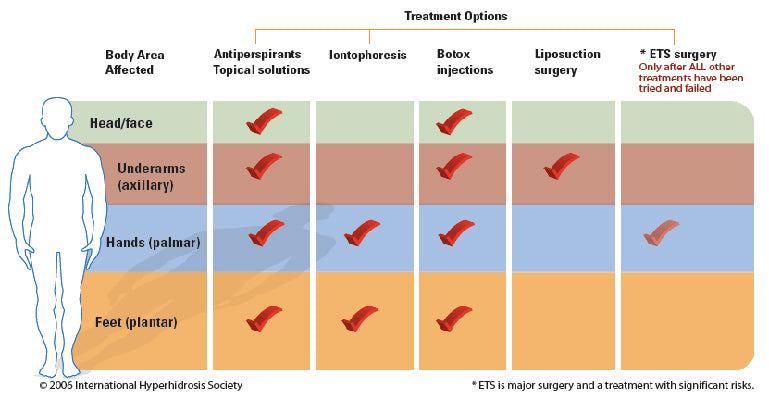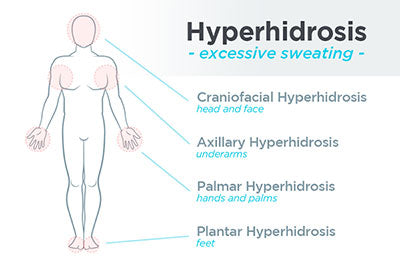What Is Hyperhidrosis?
Hyperhidrosis is a medical condition characterized by excessive sweating.
Hyperhidrosis is relatively rare and generally manifests itself in four ways, based on the body areas affected:
- Palmar hyperhidrosis (hands)
- Plantar hyperhidrosis (feet)
- Craniofacial hyperhidrosis (head and face)
- Axillary hyperhidrosis (armpits)
What Causes Hyperhidrosis?
This is determined by the type of hyperhidrosis a person suffers from.
Primary Hyperhidrosis
In many instances, the exact cause of hyperhidrosis is unclear. It is, however, believed to stem from a problem with the part of the nervous system that controls sweating.
There's also the possibility that genetics play a role in this.
Secondary Hyperhidrosis
This refers to hyperhidrosis that has an identifiable cause.
To better understand the condition, it's important to consider how the body produces sweat.
There are millions of sweat glands distributed all over our bodies. Most of these are eccrine glands that secrete a clear, odorless fluid to regulate body temperature.
Hyperhidrosis is therefore characterized by overactive eccrine glands.
We also have apocrine glands, which produce a thick fluid. When the fluid comes into contact with bacteria on the skin’s surface, the result is body odor.
Both eccrine and apocrine glands are activated by nerves due to stimuli including:
- Heat
- Stress
- Physical activity
- Hormones
If someone has hyperhidrosis, their sweat glands (particularly the eccrine glands) overreact to stimuli, thus producing more sweat than necessary.
Hyperhidrosis can also be termed as localized or generalized.
Localized hyperhidrosis affects the face, palms, soles, and armpits. Usually, it begins in adolescence, but can also manifest in childhood or infancy. It is caused by:
- Emotional stress (particularly anxiety)
- Heat
- Certain foods, including spices, peanut butter, citric acid, coffee, and chocolate
- Injury to the spinal cord
Generalized hyperhidrosis affects large areas of the body, mostly in adults whose sweating occurs when either asleep or awake. Common causes of generalized hyperhidrosis are:
- Heat and humidity
- Exercise and physical activity
- Infections, such as tuberculosis
- Malignancies (e.g. lymphatic cancer)
- Metabolic diseases and disorders, such as hyperthyroidism, hypoglycemia, diabetes, and gout
- Autonomic dysfunction
- Menopause
- Psychological stress
- Certain prescription drugs
Who Does Hyperhidrosis Affect?
Hyperhidrosis affects people indiscriminately, regardless of age or gender.
It is estimated that hyperhidrosis affects roughly 3 percent of the world's population. A significant number of people living with it have never received a diagnosis or treatment, even though they exhibit symptoms unique to this condition.
This is attributed to a lack of awareness of the condition itself and how it can best be managed.
How Serious Is Hyperhidrosis?
Hyperhidrosis is not life-threatening. Nevertheless, it can impede the enjoyment of everyday activities.
Excess sweat may cause the skin to wrinkle and crack and affected areas may become red and inflamed.
As such, hyperhidrosis affects a person's quality of life regardless of where it occurs. Its effects touch on a person's self-esteem, mood, and interaction with others.
Consequently, the condition can result in embarrassment, anxiety, and even depression.
People affected by hyperhidrosis often require medical care.
How Is Hyperhidrosis Diagnosed?
It's important to see your doctor if you suspect that you may have hyperhidrosis.
The doctor will then perform one of these tests:
- Paper test: in this test, a special paper is placed on the affected area to absorb sweat. It is then assessed to determine how much sweating occurs.
- Starch & iodine test: for this test, a solution containing iodine is applied to the sweaty area. Starch is then sprinkled over the area. If the starch-iodine combination turns a dark blue color, this will be an indication of where sweat production is in excess.
After this, additional lab tests will be undertaken to rule out other conditions characterized by profuse sweating.
These include:
- Blood glucose tests
- Thyroid function tests
- Uric acid level measurements
How Is Hyperhidrosis Treated?
For patients with localized hyperhidrosis, there are numerous treatment options available. These typically involve initial treatment using ointments or salves that make sweat glands much drier.
Both prescription and non-prescription antiperspirants also reduce sweating in and around the armpits. They can also be used to treat mild hyperhidrosis in hands and feet.

Image: CastleknockCosmetics
Iontophoresis
For this treatment, feet or hands are placed in a water pan where an electrical current passes through.
The low-voltage current courses through the water and stuns the sweat glands. The result is decreased sweat production for about a week.
Though it can be painful, it works, with up to 80 percent of patients who undergo the treatment recovering from excessive sweating.
For it to be highly effective, iontophoresis should be done every other day for six to ten treatments, after which a person may notice reduced sweating.
Botulinum Toxin Type A Injection
Botulinum toxin type A (commonly known as Botox) is another treatment option.
It affects the nerve endings by reducing the frequency with which nerve impulses get transmitted to sweat glands.
To maximize effectiveness, multiple injections of Botox are required. These may offer relief from hyperhidrosis for a period of up to 12 months.
Surgery
Surgery may be recommended if medical treatments have failed to effectively manage hyperhidrosis.
It may be the most viable option for severe palmar or axillary hyperhidrosis. Whether or not surgery is appropriate comes down to the doctor's assessment of an individual case.
Should surgery be needed, a minimally invasive procedure is used to "turn off" the signal that causes sweating. This procedure is called thoracoscopic sympathectomy.
It involves interrupting a singled-out part of the main sympathetic nerve.
Each branch of sympathetic nerves originates from a ganglion, which is a bundle of cells.
Small incisions are made under a patient's armpits, after which the ganglion that causes sweating is taken out.
This is done by inserting a small camera (called a thoracoscope) into the area, enabling the surgeon to identify the specific ganglion that needs to be removed.
Because of the camera usage, this procedure is also referred to as video-assisted thoracic sympathectomy.
During the procedure - which normally lasts for two hours - patients are usually under general anesthesia. Once the surgery is completed, most of them return home on the same day.
Given that there are numerous ways of dealing with it, hyperhidrosis is a condition which is relatively easy to manage.
Stay Dry
Sweat can catch you by surprise at any point throughout your day. From office boardrooms, your daily commute, or dinner with friends.
Don’t be caught off-guard. Stay dry with quality sweat-proof undershirts from Sweatshield. With a variety of styles and sizes, you need never be stuck in a sweaty and uncomfortable situation again.
Don’t sweat the small stuff. Try Sweatshield and get back to enjoying your life.
Photo: Hans Reniers










